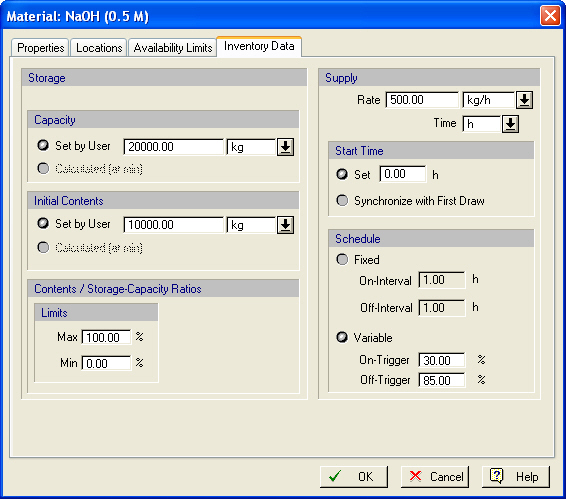

This tab is part of the dialog that presents the properties of a material that enters the process (as a resource).
•Storage Capacity
If you wish to specify a limit on the amount of material that can be consumed (as a total) over a specified window of time, you may specify it on this tab. Check the “Cumulative Amount Limit” check box and then type in the limit amount in the units of your choice. Please note that the selected units are not necessarily the units that the cumulative amount will be plotted.
•Initial Contents
If there’s a rate (or distribution) limit on the selected component you may provide it here. Select the “Rate Limit” check box and type in the limit in the units of your choosing. Please note that the selected units may not necessarily be the same as the units chosen to display the material graph.
•Contents / Storage Capacity Ratios (Min/Max)
Sometimes it is more convenient to specify a time-average rate limit. Click on the “Time-averaged Rate Limit” check box and specify the value and the time window used for the averaging. This limit may represent This rate may represent an approximation of the replenish (or removal) rate possible for the selected ingredient, in lieu of detailed inventory information.
•Supply (or Removal) Rate
When the on-trigger activates the re-supply (or emptying) of material it is assumed that the supply (or removal) process proceeds at this specified rate.
•Supply (or Removal) Start Time
The very first time the inventory is checked for supply (or emptying) can be the beginning of the batch (0h) or any specified time point (with respect to the beginning of the batch) or simply coincide with the first time the storage has been accessed for material draw (in case of material consumption) or material deposit (in case of material output).
•Supply (or Removal) Strategy/Schedule
You may elect between two possible strategies:
A fixed-time (interval-based) strategy: in this case you specify two intervals: one during which the storage is being re-supplied (or emptied) at the rate specified earlier and another during which the storage is just available for drawing (or depositing) of material.
A variable-time strategy where the on/off triggers for re-supply (or emptying) are based on the contents-to-storage capacity ratios. For materials entering the process, when the contained material falls below the on-trigger (low) value, the inventory is being supplied with fresh material at the provided rate; when the contained material-to-storage capacity ratio reaches the off-trigger (high) value mark, the material is no longer assumed to be supplied to the inventory. In case of a material depositing inventory (for material exiting the process), the removal of material is triggered on when the contents-to-storage ratio exceeds the on-trigger (high) ratio and stops when the materials-to-trigger ratio reaches the off-trigger (low) value.